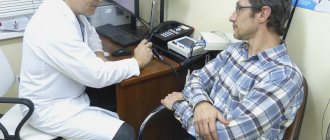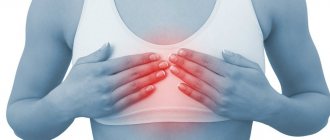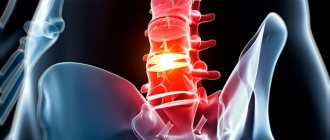Vertebrogenic cervicalgia is a common pathology among middle-aged people engaged in sedentary mental work. Prolonged tension in the muscles of the neck and collar area provokes the development of pathologies of the spinal column. These, in turn, cause severe pain.
In this article you can find out more information about the symptoms and treatment of vertebrogenic cervicalgia, and understand the potential causes of the development of this disease. This information will help you make the right decision about effective and safe treatment. You will also be able to independently recognize the first signs of trouble and seek medical help in time.
Acute vertebrogenic cervicalgia is the primary appearance of pain in the neck and collar area. It can occur after a long static position of the body and head, an incorrectly chosen position for night sleep, traumatic effects on the spinal column, etc. If within 5 - 7 days this syndrome does not go away completely, then doctors talk about the disease becoming chronic. currents.
Chronic vertebrogenic cervicalgia has an undulating course. Periods of remission (complete absence of symptoms) are followed by exacerbations (with severe pain and limited mobility). Official medicine is able to offer patients with this pathology only symptomatic treatment. During an exacerbation, non-steroidal anti-inflammatory drugs are prescribed in combination with muscle relaxants. This allows the period of remission to return and the patient can begin his work. But the cause of the pathology does not disappear at this time and destructive processes continue.
It is important to understand that vertebrogenic cervicalgia syndrome is secondary. In the foreground, such patients always have a chronic disease of the musculoskeletal system. Most often these are degenerative dystrophic changes in the cartilaginous tissues of the intervertebral discs. Osteochondrosis can provoke the development of protrusion, extrusion and intervertebral hernia - these conditions also lead to cervicalgia. The negative impact of rheumatic and post-traumatic deformities cannot be ruled out.
To begin treatment of vertebrogenic cervicalgia, it is necessary to carry out a full differential diagnosis, the doctor must establish the potential cause of the development of pain and correct this condition by available means. Then work is carried out to restore the functionality of the muscles of the neck and collar area, improve the processes of nerve impulses, etc.
If you notice the first signs of vertebrogenic cervicalgia, do not self-treat under any circumstances. Do not use analgesic drugs or ointments. This will only worsen the health of your spinal column. Seek medical help from a vertebrologist or neurologist. These doctors have sufficient professional competence to make an accurate diagnosis and prescribe adequate and safe treatment for the patient’s health.
In Moscow, you can make a free appointment with a vertebrologist and neurologist at our manual therapy clinic. Experienced doctors work here. They will conduct a full examination and give you a preliminary diagnosis. You will then be given individual recommendations for further examination and treatment. To register, use the special form located further on the page.
What causes vertebrogenic headache?
Vertebrogenic headache is of a neuralgic nature.
It appears due to false impulses arising in the nerve fibers of the cervical spine, or due to disruption of the cerebral blood supply due to pinching of the vertebral arteries by intervertebral discs. Osteochondrosis occurs due to wear of the intervertebral discs, which is facilitated by excessive stress on the spine. They shift and become smaller in size (flatten), causing the nerve fibers along the spine to experience excessive pressure and also become more susceptible.
Displaced discs compress blood vessels, especially the vertebral arteries - the two largest vessels running along the spinal column, which are responsible for feeding the brain.
So, vertebrogenic headache occurs due to two main reasons:
- insufficient blood supply to the brain;
- pinched nerve roots.
The development of such conditions is facilitated by sedentary work, poor diet, lack of physical activity, exposure to tobacco smoke and chemical toxic substances, spinal injuries and poor environmental conditions.
Causes of cervicalgia syndrome of vertebrogenic origin
Vertebrogenic moderate cervicalgia can appear in completely healthy people under the influence of a number of pathogenic factors. For example, prolonged work at a computer with excessive tension in the muscles of the neck and collar area can cause spasm of myocytes, which will lead to severe pain. However, this condition is different in that it goes away completely on its own (without the use of medications) within a few hours.
Similar manifestations may appear after visiting a bathhouse or sauna, exposure to a draft, emotional stress, etc.
True cervicalgia syndrome of vertebrogenic origin is always a complication of diseases of the tissues of the spinal column. Potential causes include the following pathologies:
- cicatricial deformation of the ligamentous and tendon apparatus after multiple injuries (for example, sprains and ruptures);
- degenerative dystrophic changes in the cartilage tissues of the intervertebral discs (osteochondrosis);
- complications of long-term osteochondrosis, such as protrusion (decrease in the height of the intervertebral disc), extrusion (rupture of the fibrous ring) and intervertebral hernia (exit of part of the nucleus pulposus through the rupture);
- deforming osteoarthritis of the uncovertebral, facet and facet joints in the cervical spine;
- instability of the position of the vertebral bodies, their dislocations and subluxations, displacements such as antelesthesis and retrolisthesis;
- curvature of the spinal column, including in the thoracic region with compensatory displacement of the vertebrae in the neck;
- consequences of injuries in the form of cracks and fractures of the bone tissue of the vertebral bodies and their processes;
- rheumatoid processes such as systemic lupus erythematosus, ankylosing spondylitis, scleroderma, etc.
In old age, vertebrogenic cervicalgia is a consequence of the destruction of bone tissue (osteoporosis). The vertebral bodies sag, the length of the spinal canal decreases. This leads to compression of the hard membranes of the spinal cord, narrowing of the foraminal openings through which the radicular nerves depart.
The development of vertebrogenic cervicalgia syndrome can be triggered by emotional shock, muscle inflammation and a deficiency of certain microelements responsible for the transmission of nerve impulses.
Make an appointment
To register, choose any method:
- call the clinic +7 (495) 103-99-55,
- order a call back,
- leave a request for an appointment using a convenient form on the website:
Headache is a seemingly symptom that occurs periodically in all people.
IMPORTANT! However, vertebrogenic headache is a more serious symptom that indicates the development of osteochondrosis of the cervical spine.
In this case, the patient experiences many other unpleasant symptoms, ranging from a burning sensation in various parts of the head to tinnitus and darkening of the eyes. Vertebrogenic headache cannot be ignored - if treatment is not started in time, complications in the form of intensive development of osteochondrosis will not keep you waiting. Book a consultation with an experienced neurologist at our center to eliminate vertebrogenic headaches!
SIGN UP
Symptoms
The main manifestation of this disease is pain . Cervicalgia is accompanied by a lot of symptoms, but muscular-tonic syndrome is more often observed. In this case, the neck muscles become denser, and if you press on them, the pain intensifies.
Other symptoms include:
- The movement of the head is accompanied by a specific crunching sound.
- Throbbing headache, as well as dizziness.
- Restricted neck mobility.
- When you tilt your head back, fainting occurs.
- Partial loss of vision and hearing.
- The pain spreads to one of the arms and shoulder.
- The gait becomes unsteady.
- The upper limbs become weak.
- Tingling, as well as numbness of the face, hands and back of the head.
- Nausea, but no vomiting.
- When coughing or sneezing, the pain worsens.
Such symptoms are typical for any person, regardless of gender and age . In chronic cervicalgia, the symptoms are less pronounced, in contrast to the acute disease. In case of hypothermia or spinal injury, the pain is intense and severely hinders movement. When the disease occurs against the background of a concomitant disease, the pain is usually mild.
Video: “All causes of neck pain”
Symptoms of vertebrogenic headache
Symptoms of vertebrogenic headache depend on its cause.
If your head hurts due to a lack of oxygen in the brain, i.e. compression of blood vessels, the following complaints may appear:
- burning, pulsation in the occipital, parietal, temporal regions;
- pain “radiates” to the eye sockets;
- nausea leading to vomiting;
- noise in ears;
- darkening of the eyes.
IMPORTANT! These symptoms are combined into vertebrobasilar insufficiency syndrome, or cerebral blood supply disorder.
In some cases, a person notes insomnia, tearing and redness of the facial skin.
When the structures of the nervous tissue are compressed, the patient complains of:
- acute intense unilateral pain;
- less often - impaired swallowing and difficulty speaking.
IMPORTANT! If the pain is caused by a lack of blood supply, it will intensify with loud sounds and bright light, with compression of the nerve roots - during physical activity.
Symptoms appear more clearly if osteochondrosis is accompanied by hypertension or increased intracranial pressure.
Vertebrogenic cervicalgia
Often the occurrence of vertebrogenic cervicalgia is accompanied by other diseases, including rheumatoid arthritis, vertebral hernia, osteoporosis and some others. To make a final diagnosis, the patient must undergo a series of studies, including: magnetic resonance imaging, radiography and CT. If treatment of the disease is started in a timely manner, a positive result will not take long to appear and the chances of a speedy recovery increase. The chronic form of vertebrogenic cervicalgia is much more difficult to treat with medication, since the situation is complicated by systematic relapses.
Main causes of the disease
It should be noted that the negative impact on the human body of the above-mentioned spinal ailments is not always the cause of the appearance of cervical pain syndrome. Very often, the key factors for the development of the disease are excessive physical stress on the muscles and vertebrae located in the neck. In addition, pain can occur due to hypothermia, infectious infection or osteochondrosis.
Clinical picture
With vertebrogenic cervicalgia, the most “recognizable” symptom is considered to be severe pain of varying degrees of intensity. In this case, the nature of the sensation can be very diverse, starting from mild tingling and ending with prolonged spasms. Other common symptoms of the disease include the following:
- pain in the back of the head;
- presence of noise in the ears;
- feeling of numbness in the upper extremities, including the back of the head.
Diagnosis of the disease
The effectiveness of diagnostics directly depends on the competent performance of clinical tests. Information about the patient collected in the anamnesis is also important. Particular attention should be paid to the time of the first onset of pain. After a thorough examination and interview of the patient, you can move on to other diagnostic procedures: MRI, X-ray examination of the cervical region, CT and some others. Of the well-known methods of functional diagnostics, electroneuromyography is usually used.
Principles of disease treatment
In most cases, proven conservative methods of therapy are used as the main treatment for vertebrogenic cervicalgia. For example, non-steroidal anti-inflammatory drugs and pain-blocking drugs are widely used. Also, if necessary, special medications are prescribed to relieve swelling - muscle relaxants to reduce muscle spasms.
There are a number of additional methods that help cope with the disease.
For example, a certain positive effect is achieved from the use of a special neck collar, as well as spinal traction procedures. Of the various preventive methods, doctors primarily give preference to the mandatory use of an orthopedic mattress and pillow, physiotherapeutic procedures and exercises from a course of therapeutic exercises. Author: K.M.N., Academician of the Russian Academy of Medical Sciences M.A. Bobyr
Diagnosis of vertebrogenic headache
If you suspect a vertebrogenic headache, you can immediately contact a neurologist. You can also make an appointment with a therapist, who will write a referral to a specialist.
In addition to collecting anamnesis and examination, the doctor will need data from other studies.
- X-ray of the cervical spine.
- MRI of the cervical spine.
- Angiography of cerebral vessels.
- Dopplerography.
After a detailed diagnosis, a final diagnosis is made and treatment is selected.
Treatment of vertebrogenic headache
The main feature of treatment is an integrated approach. Therapeutic measures are aimed not only at alleviating the condition, but also at preventing recurrent attacks, as well as normalizing blood supply to the brain and the functioning of nerve cells.
To relieve symptoms, medications are prescribed that have pronounced analgesic, anti-inflammatory and anti-edematous effects. Typically, muscle relaxants (drugs for muscle spasms), angioprotectors (drugs that strengthen and protect the walls of blood vessels), vasodilators, and B vitamins are used. In more complex cases, hormonal therapy is prescribed.
ATTENTION! In case of a pronounced pain symptom, novocaine blockade is required - the introduction of novocaine (an effective painkiller) into the muscle tissue.
In addition to drug therapy, manual therapy is necessarily prescribed, which plays a key role in the treatment of vertebrogenic headaches and osteochondrosis. It is often accompanied by a massage.
Mechanical effects on muscles, joints and cartilage contribute to:
- removal of toxins, waste products, decay products, excess salts from tissues;
- increased lymph flow;
- improving blood movement through the vessels;
- relieving muscle spasms;
- realignment of the spine.
To achieve a lasting, long-lasting result, you need to undergo a course of massage and manual therapy sessions.
Make an appointment
To register, choose any method:
- call the clinic +7 (495) 103-99-55,
- order a call back,
- leave a request for an appointment using a convenient form on the website:
SIGN UP
Rehabilitation and lifestyle after treatment
It is necessary to regularly eat fresh fruits and vegetables rich in vitamins, engage in physical therapy, avoid hypothermia, being in a draft or under air conditioning, and sudden movements.
People with sedentary jobs need to set aside 5 minutes for a short “physical education break” every hour, and walk for at least an hour every day.
Also, people with dystrophic changes in the spine need to go to a massage therapist and chiropractor for prevention once every 1-2 months.










